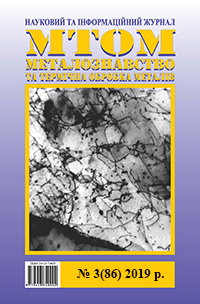The study of heat energy transfer through the porous structure of the intermetallide catalyst
DOI:
https://doi.org/10.30838/J.PMHTM.2413.250619.26.318Keywords:
intermetallide, catalyst, porosity, backfill, temperature, catalytic activityAbstract
Abstract. Purpose. The purpose of the work is to find verified dependences for the calculation of heat and mass exchange processes in the porous structures of intermetallide catalysts, as well as to establish interdependences between the structure of the catalyst and its thermal characteristics. Methodology. The object of study was selected intermetallide catalysts of the Ni−Al system with a various granule filling scheme: in-line and staggered arrangement. To simulate the processes of heat and mass exchange, computer simulation with grid methods was used. To obtain experimental data, tests of a known composition of the catalyst obtained under thermochemical pressing were carried out. The catalytic activity and specific surface area of the catalyst obtained were evaluated. Findings. It was established that the staggered arrangement of the catalyst granules exhibits a large catalytic activity already in the initial period of time, its activity gradually increases with increasing temperature, reaching a maximum value in the investigated temperature range at T = 300 °C. The conversion of carbon monoxide at the staggered arrangement in the initial oxidation period exceeds NiAl3 in-line arrangement by 1.3…1.5 times. However, the use of a staggered intermetallide catalyst backfill as a catalyst in the oxidation of carbon monoxide will be subjected to coking to much greater extent than a in-line backfill (high density of backfill), as a result of which it will be deactivated much faster. Originality. Research largely eliminates the gap formed between the practice of formation of thermophysical properties and information about changes in the structure and properties of intermetallide catalysts. Practical value. Research allows us to expand the scope of high-performance methods for producing porous intermetallide alloys in the technology of catalysts and to improve their quality.
References
Arkatova L.A. Intermetallides as the catalysts for carbon dioxide reforming of methane / L.A. Arkatova // Catalysis Today. – 2018. – Vol. 299. – Pp. 303−316.
Armbrüster M. Intermetallic compounds in heterogeneous catalysis – A quickly developing field / M. Armbrüster,
R. Schlögl, Y. Grin // Science and Technology of Advanced Materials. – 2014. – Vol. 15. – Issue 3. – № 034803. doi: 10.1088/1468-6996/15/3/034803
Liu Q. CO methanation on ordered mesoporous Ni–Cr–Al catalysts: Effects of the catalyst structure and Cr promoter on the catalytic properties / Q. Liu, Z. Zhong, F.Gu // Journal of Catalysis. – 2016. – Vol. 337. – Pp. 221−232.
Чейлытко А. А. Исследование формирования пор во вспучивающемся материале / А. А. Чейлытко // Технологический аудит и резервы производства. – 2013. – № 13. – С. 38–40.
Чудновский, А. Ф. Теплофизические характеристики дисперсных материалов / А. Ф. Чудновский. – Москва : Государственное издательство физико-математической литературы, 1962. – 456 с.
Freire–Gormaly M. The pore structure of indiana limestone and pink dolomite for the modeling of carbon dioxide in geologic carbonate rock formations / M. Freire–Gormaly // Department of Mechanical and Industrial Engineering. – University of Toronto, 2013, 96 р. Режим доступу: https://pdfs.semanticscholar.org/2a3f/8457780b1a9bae542007d53a81c2a7c8c464.pdf
Environmental assessment of the intermetallic catalysts utilization efficiency for deactivation of the pollutants emitted by electrode production enterprises / K.V. Belokon, Y.A. Belokon, G.B. Kozhemyakin, E.V. Matukhno // Scientific bulletin of National Mining University. – № 3 (153). – 2016. – P. 87–94.
References
Arkatova L.A. Intermetallides as the catalysts for carbon dioxide reforming of methane. Catalysis Today, vol. 299,
pp. 303−316 (2018).
Armbrüster M., Schlögl R., Grin Y. Intermetallic compounds in heterogeneous catalysis – A quickly developing field, Science and Technology of Advanced Materials, 2014, vol. 15, issue 3, № 034803. doi: 10.1088/1468-6996/15/3/034803
Liu, Q. Zhong Z., Gu F. CO methanation on ordered mesoporous Ni−Cr–Al catalysts: Effects of the catalyst structure and Cr promoter on the catalytic properties, Journal of Catalysis, 2016, vol. 337, pp. 221–232.
Cheylytko A. Issledovanie formirovaniya por vo vspuchivayuschemsya materiale [Investigation of pore formation in intumescent material]. Tehnologicheskiy audit i rezervyi proizvodstva [Technological audit and production reserves]. 2013, no. 13, pp. 38–40 (in Russian).
Chudnovsky A.F. Teplofizicheskie harakteristiki dispersnyih materialov [Thermophysical characteristics of dispersed materials]. Moscow : State Publishing House of Physics and Mathematics, 1962, 456 p. (in Russian).
Freire-Gormaly M. The pore structure of indiana limestone and pink dolomite for the modeling of carbon dioxide in geologic carbonate rock formations. Department of Mechanical and Industrial Engineering, University of Toronto, 2013, 96 p.
Belokon K., Belokon Y., Kozhemyakin G. and Matukhno E. Environmental assessment of the intermetallic catalysts utilization efficiency for deactivation of the pollutants emitted by electrode production enterprises. Scientific bulletin of National Mining University, 2016, no. 3 (153), pp. 87−94.
Downloads
Published
Issue
Section
License
Authors that are published in this journal agree to follow the conditions:
Authors reserve the right to the authorship of his work and cede the right to the journal of first publication of this work on conditions of the license under the Creative Commons Attribution License, which allows others to distribute it freely with the obligatory reference to the author of the original work and the first publication of the work in this journal.

